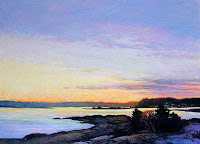McGowan Fine Art announces the opening “Sandy Wadlington – New Works”. The show will run from March 27 - April 27, 2012. A reception will take place March 30, 5-7 PM. The public is welcome.
Born and raised in New England, the region’s unique rural characteristics continue to serve as inspiration to Sandy Wadlington. “The things that interest me are color, light, composition, and a sense of place.” Working with a variety of media, pastel, caran d’ache, and colored pencil drawings will be on display. “Each has specific strengths, challenges and ways of expression”, says Wadlington.
Wadlington captures the tactility of the New England atmosphere by building up strokes and layers, which lends to a seemingly textured, yet soft, surface. “Morning, Near Cushing, Maine” portrays the Maine coast at sunrise, quiet and intimate. The cool, misty air is juxtaposed by the warmth of the emerging sunlight. The freshly fallen snow of “Portsmouth Study”, or the hazy fog of “Fog, Vinal Haven” demonstrates that Wadlington is a master at depicting these fleeting transitional moments in nature.
 Trained at the Museum School in Boston and Massachusetts College of Art, Wadlington perfected her skills while living in Texas and showing in galleries from Oregon to Japan. She returned to New England, drawn back to the natural beauty of the region. “Although I have lived in other parts of the country, I find the New England landscape especially rich and compelling”. Many of her works are based on photographs, taken by Wadlington on location.
Trained at the Museum School in Boston and Massachusetts College of Art, Wadlington perfected her skills while living in Texas and showing in galleries from Oregon to Japan. She returned to New England, drawn back to the natural beauty of the region. “Although I have lived in other parts of the country, I find the New England landscape especially rich and compelling”. Many of her works are based on photographs, taken by Wadlington on location. .

















